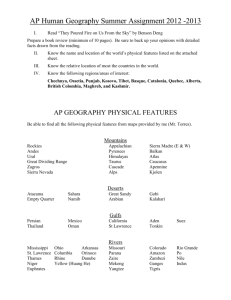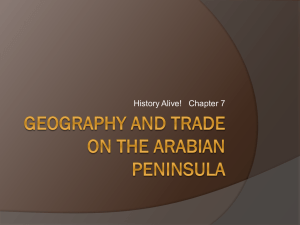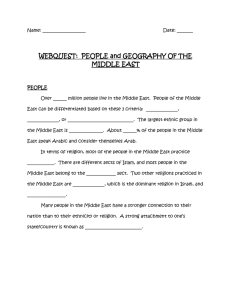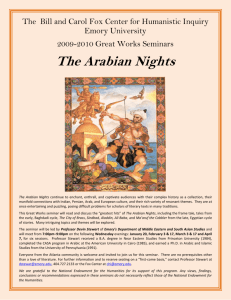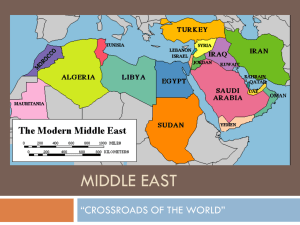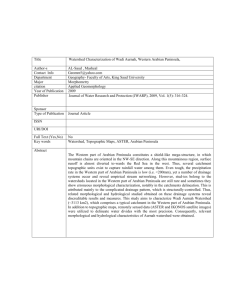Document 10465134
advertisement
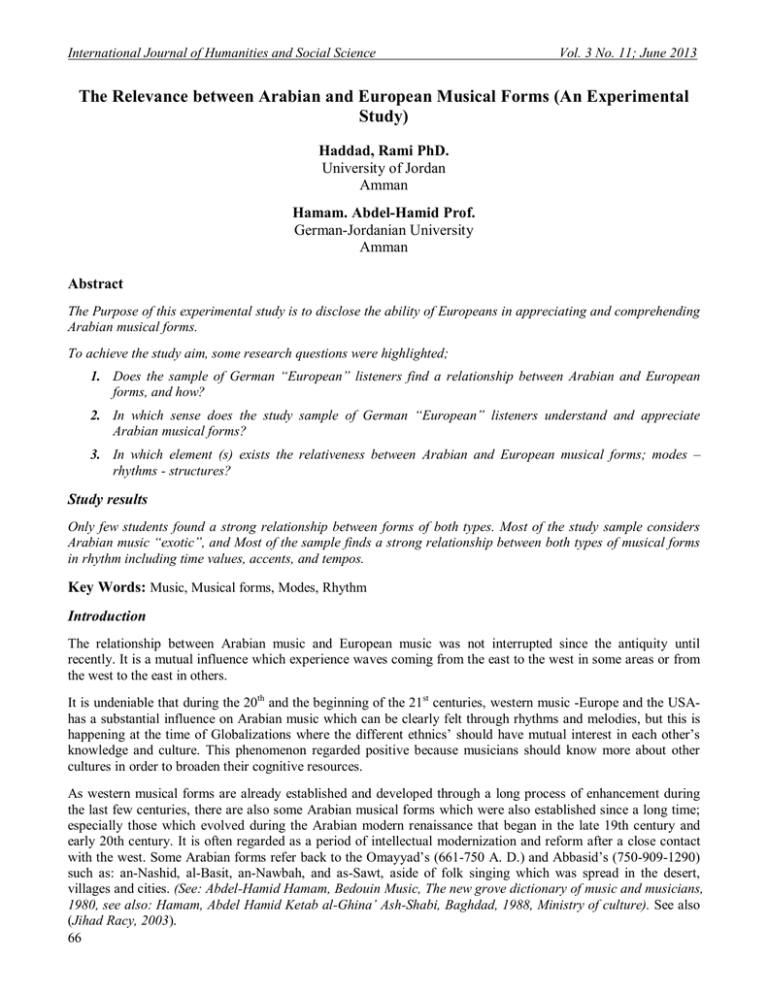
International Journal of Humanities and Social Science Vol. 3 No. 11; June 2013 The Relevance between Arabian and European Musical Forms (An Experimental Study) Haddad, Rami PhD. University of Jordan Amman Hamam. Abdel-Hamid Prof. German-Jordanian University Amman Abstract The Purpose of this experimental study is to disclose the ability of Europeans in appreciating and comprehending Arabian musical forms. To achieve the study aim, some research questions were highlighted; 1. Does the sample of German “European” listeners find a relationship between Arabian and European forms, and how? 2. In which sense does the study sample of German “European” listeners understand and appreciate Arabian musical forms? 3. In which element (s) exists the relativeness between Arabian and European musical forms; modes – rhythms - structures? Study results Only few students found a strong relationship between forms of both types. Most of the study sample considers Arabian music “exotic”, and Most of the sample finds a strong relationship between both types of musical forms in rhythm including time values, accents, and tempos. Key Words: Music, Musical forms, Modes, Rhythm Introduction The relationship between Arabian music and European music was not interrupted since the antiquity until recently. It is a mutual influence which experience waves coming from the east to the west in some areas or from the west to the east in others. It is undeniable that during the 20th and the beginning of the 21st centuries, western music -Europe and the USAhas a substantial influence on Arabian music which can be clearly felt through rhythms and melodies, but this is happening at the time of Globalizations where the different ethnics’ should have mutual interest in each other’s knowledge and culture. This phenomenon regarded positive because musicians should know more about other cultures in order to broaden their cognitive resources. As western musical forms are already established and developed through a long process of enhancement during the last few centuries, there are also some Arabian musical forms which were also established since a long time; especially those which evolved during the Arabian modern renaissance that began in the late 19th century and early 20th century. It is often regarded as a period of intellectual modernization and reform after a close contact with the west. Some Arabian forms refer back to the Omayyad’s (661-750 A. D.) and Abbasid’s (750-909-1290) such as: an-Nashid, al-Basit, an-Nawbah, and as-Sawt, aside of folk singing which was spread in the desert, villages and cities. (See: Abdel-Hamid Hamam, Bedouin Music, The new grove dictionary of music and musicians, 1980, see also: Hamam, Abdel Hamid Ketab al-Ghina’ Ash-Shabi, Baghdad, 1988, Ministry of culture). See also (Jihad Racy, 2003). 66 © Center for Promoting Ideas, USA www.ijhssnet.com Other Arabian musical forms were flourished under the Arab rule of al-Andalusia (Spain) such as: “alMuwashshah, az-Zajal and an-Nawbah al-Andalusia, and other forms which were borrowed from Ottoman culture such as al-Muwshshah al-Mashriqi, as-Samai, al-Bashraf, al-Longa and at-Tahmilah, beside some religious and Sufi anashid and Quran recitation”. All these forms have their own structures which differ from other nonArabian ones. Most of classical western forms are well known all over the world; Sonata form, symphony, opera, Fugue, etc… they became a part of worldwide culture and transferred at the time of colonialism through acculturation process to every part of the world. Enormously grew the media power at the end of the 20th and at the beginning of 21st centuries along with the proliferation of the computer technology and the Internet. This gave the great economic powers additional cultural dominance. With this empowerment of media and communication devices, it is unreasonable to neglect rule and the Arts of cultural inheritance of different ethnics and folks which accumulated through a long process of selection and enhancement resulting new trends of musical theories, practice, and performance. It is therefore an important issue to establish a grand base for future multicultural exchange, as well as introducing some different musical forms to the European audience. Arabian music is mostly characterized as a dancing music and widely used as a mean of entertainment. At the same time, some Arabic Rhythms are designed to achieve “Gleeful” or what is known in the Arabic with “Tarab”. Neubauer defined “Tarab” as the ability of music to fill the human soul either with happiness or with sadness (Neubauer, 1990, p.227). The musical form used in this experiment is the “Samai” which consists of four parts known as “Khanat” (plural of khanah) and a refrain that is known as “Taslim”. The “Samai” starts with the first Kanah, and then comes the “Taslim” which is repeated after each “Kanah”. Accordingly the form is as follows; (A-B-C-B-D-B-E-B). Key Words: Music, Arabian music, oriental music, Arabic musical forms. Study Aim This study is made to reveal the ability of Europeans in appreciating and comprehending Arabian exotic musical forms and whether if they absorb them in the same way they do when they listen to European musical forms. Study Sample To achieve the study aim, one of the researchers traveled to Germany to make the experiment by choosing a sample of “20” music students at the “Hochschule für Musik in Würzburg”. He made the practical experiment and collected the results. Study Methodology Before engaging in the experiment, the researcher explained and gave a historical background about the relationship between Arabian and European music and the essential differences between them. The lecture included an elaboration of the most familiar Arabian musical forms, how they are structured and the relation between tempo and form; for example in (Longa) form a fast tempo is used during the whole piece as well as the time signature of 2/4, whereas in the (Sama’i) form relatively slow tempo is used in the first three parts (Khanat) with compound time (usually 10/8), and a dancing tempo is mostly used at the last (Khanah) of it with a time signature of 3/4 (Kamel et. al. 1980 P. p. 138 – 140). Afterwards, students are subjected to a process of listening to some Arabic musical pieces chosen by the researchers without knowing which kind of form they are listening to, and at the end of the piece they are requested to give their opinion in what they already heard; structure, relevance to European forms, and general impression about the whole piece. All answers, comments, and remarks of the study sample are written down, categorized and analyzed by both researchers and the results undoubtedly appeared fascinating. Statement of Problem This study is made to disclose the relevance between some exotic Arabian musical forms and European ones from the point of view of an occidental audience, for this purpose a set of questions are addressed in the study 67 International Journal of Humanities and Social Science Vol. 3 No. 11; June 2013 Research Questions 1. Does the sample of German “European” listeners find a relationship between Arabian and European forms, and how? 2. In which sense does the study sample of German “European” listeners understand and appreciate Arabian musical forms? 3. In which element exists the relativeness between both musical forms: modes, rhythms, or structures? Characteristics of Arabic Music Music in general and Arabian music as well is based on the organization of sounds in time. The elements of music are the basics aspects for distinguishing it from other sounds: Pitch, dynamics, tone color, and duration (Kamien, 2000, P. 4). Beside the basic elements of music mentioned previously, Harmony is a basic element in European musical composition as well as the musical shape which is defined as a pattern of an element (melody, rhythm, harmony) or a combination of elements (Rumery 1992, P. 4). Arabian music is characterized with mostly a single melodic line. Moreover; it has the three quarter-tone that distinguishes it from other music and that endows Arabian music with a particular taste. Nevertheless the ancient Arabic music was only coupled with singing, but through time, especially during the Turkish rule of the Arab world, “instrumental music” started to emerge in Arabian compositions deriving from Turkish forms such as "Beshrew", "Longa", "Sama'i" etc. (Kamel, ibid, p. 140), later on, and during the 20th century, Arabian music imitated some Western music forms such as concerto and sonata. Nevertheless, most of the ancient Arabian musical compositions and songs were not scored or even documented, but it is survived until recent because Arabs used to memorize them and teach them orally to new generations (Jargy, 1989 p. 50). The existence of the three-quarter tone makes a difference not only in the variety and the diversity of melodies, but also with the effect and the taste that the listener can understand, absorbs, and enjoy simultaneously during the existence of other elements. To assign the three-quartertone a symbol of half sharp (≠) or half flat (ҍ) is added, leading the performer to ascend or descend quarter ton depending on the sign before it; the symbol could also appear in the key signature. Jargy claims that the western listener understands Arabian music as a mixture of incoherent sounds that are not linked by any Harmony, and is unpleasant, primitive, and poor with aesthetic feelings, and causes despair (Jargy, ibid. p. 49). This claim could be valid only at that time where global communication facilities were almost not available for everyone which resulted a lack of global awareness of other cultures. Review of Some Related Literature In her article published in “Chronicles of higher education” Johanna Keller profiles cellist “yo-yo Ma” and his Silk Road project which he began in 1997. This project produced hundreds of musical performances and educational events, three recordings and twenty four commissioned works by international composers. The performers involved share music from the different cultures all through the Silk Road, from the Pacific Ocean to the Mediterranean. The article embraces different genres of music which are related together and express the difference of space and culture through the Silk Road (Kellet, 2007). In a research carried out during the summer of 2007 and entitled "Integration of Arabic and western music through introducing Arabic music in The German primary curricula” Haddad R. N. (2008) has discovered that most of the study sample had positive responses, and that they enjoyed listening to Arabic music. The study also showed that Arabic music could be enjoyed and appreciated by European listeners. In his book “making music in the Arab world” Racy A. J. (2003)” describes how Arab composers (Mulahhinin) compose and perform Arabian music; he also presents the methodology of Arab instrumentalists, singers and the role of the audience in a performance. Also the Arabic musicologist Tuma, H. (1975) introduces in his book “Die Musik der Araber” a concise history of Arabian music, its theory, forms, and styles of music and performance traditions. In 1976 and in his book “Die Musikalische Form als Prozess” Assafjew examines the Form in two ways; firstly from the intonative nature of music resulting through an acoustic-dynamical process of meaningful sound happening and its production in a composing creativity process, and secondly the historical process lives in ‘social selection’ of intonations which crystalizes into form scheme. 68 © Center for Promoting Ideas, USA www.ijhssnet.com The author deals with the form as a result of language and style of living. This idea leads to clarify the connection between language and music and that both are only understood from the society or people who master or learn both of them. Aniruddh D. P. (2008) reviews in his book “Music Language and the Brain” the process of understanding, appreciating and producing music by the brain. The comparison between language and music was for a special interest in this article. It is said that music is a language or –sometimes- a world language; but –in reality- there are many languages, of them a person could only understand one or more which he already experienced or learned. It is not easy for a European –for example - to appreciate Arabian music unless he pays some effort and time discovering its beauty (Aniruddh, 2008, P.p. 240-242). In our experience both as researchers we remember that we forced ourselves to hear classical European music, when we were still schoolboys; it was not easy for us to appreciate and follow that music, until we started to catch the melodies first –because Arabian music is essentially melodic and monotonic - and try to sing and play them. Rhythmic pieces were easier to follow than sonatas or symphonic pieces in Sonata Form for example. Hearing and enjoying popular western songs was much easier for us, because words and melodies make a combination easier to follow, understand and to memorize. Without training the memory, the perception of music would not advance; this is the reason behind understanding the language and the music of a specific region (Assafjew, 1976, P 27). Study Results and Interpretations It was obvious that a very few number of students where familiar with Arabian music in general and Arabian forms specifically; (5) out of (20) heard occasionally Arabian music and (2) have never heard any of it. Regarding the first question: Does the study sample of German “European” listeners find a relationship between Arabian and European forms, and in which meaning? Only three out of twenty students agree that there is a strong relationship between forms of both types “European classical forms and Arabian” in general, four students pointed that there is a fair relation between them, eleven students find a weak relationship between both types, and only two students did not find any relation. It was obvious that most of the students find Arabian forms in general different than the Europeans, but a few find them similar. These answers clarify the need to hear more Arabian music, because the Arabian forms are different and difficult to be understood. However, these outcomes could be resulted because Arab musicians use free interpretation style which has a link to improvisation (The Garland Encyclopedia, 2002, p.1, pp. 10-11). The second question was: In which sense does the study sample of German “European” listeners understand and appreciate Arabian musical forms? Eleven Students consider Arabian music “exotic”, only three consider it as “familiar”, four students found it “pleasing” and the remaining answer describe it as “acceptable”. The reaction of the students towards appreciating Arabian music seems fluctuating between “exotic and acceptable”. These results could appear because most of them did not have a close contact with Arabian music. It is understandable that students have little information, because the European curricula do not include any information about foreign musical forms in general, especially Arabian forms. The third question was: In which elements exists the relativeness among both musical forms; modes, rhythms, or structures? By looking at the general responses makes us believe that the sample find a strong relationship between both types of musical forms in rhythm including time values, accents, and tempos. They had the most positive response of a good relationship as soon they heard the last part of the Arabian form “Sama’i” with a time signature of 3/4. It is to say that in Arabian music the relationship between form and rhythm is clear, mostly because the melodic lines and the rhythmic pattern which accompany them are well combined. Modulation to other scales or “Maqams” plays a minor role than what can be observed in European music. Recommendations After reviewing the results of the study the researchers, reached the following recommendations; 69 International Journal of Humanities and Social Science Vol. 3 No. 11; June 2013 European student should have more information about Arabian music in general and its forms, to enlarge their knowledge and to develop their creativity. The European curricula should, also, include more information about exotic music especially Arabian music, in order to better understanding between peoples of the world in the age of globalization. Hearing different sorts of music develops and enlarge the capacity of understanding and appreciation of other peoples through music in addition to recognize the beauty of other people’s music. There should be more research about the same subject to arrive to better results. It was a very nice experience for me to meet different peoples in Germany from different levels and standers. References Aniruddh D. P. (2008). Music Language and the Brain. Oxford University Press, New York and London. xi +513. Assafjew, B. (1976) Die Musikalische Form als Prozess. Dieter Lehmann und Eberhard Lippold. Verlage Neue Musik, Berlin, 412 Pp. Haddad, R. (2008). Integration of Arabic and Western Music by Means of Introducing Arabic Music in German Primary Music Curricula. Musik – Tanz – und Kunsttherapie, 19. Jahrgang/Heft 1/ 15-18. Jargy, S. (1989) Arabian Music. Translated into Arabic by Khayat, J. House of cultural affairs publication. Bagdad. 110. Kamel M. et. al. (1980). Fundamentals of Arabian music – history and appreciation, General committee for Emirates Press, Cairo. 159 Pp. Kamien, R. (2000), Music – an Appreciation. 7th addition. McGraw- Hill, Companies, Inc. U. S. A. 738. Neubauer, E. (1990) Arabische Anleitungen Zur Musiktherapie [Sonderdruck]. Zeitschrift Fuer Geschichte der Arabisch - Islamischen wissenschaften 6, 227. Racy, A. J. (2003). Making Music in the Arab world. Cambridge University Press, 264. Rimery, K. (1992) . introduction to musical design. Vol. 1. Wm. C. Brown Publishers (WCB). U. S. A. 458. Tuma H. (1975). Die Musik der Araber. Heinrichshofen’s verlag, Wilhelmshaven, 192. Internet References Keller, J. (2007). http://chronicle.com Section: The Chronicle Review Volume 53, Issue 29, Page B10. Available under: http://chronicle.com/article/Yo-Yo-Mas-Edge-Effect/1744/ 70
